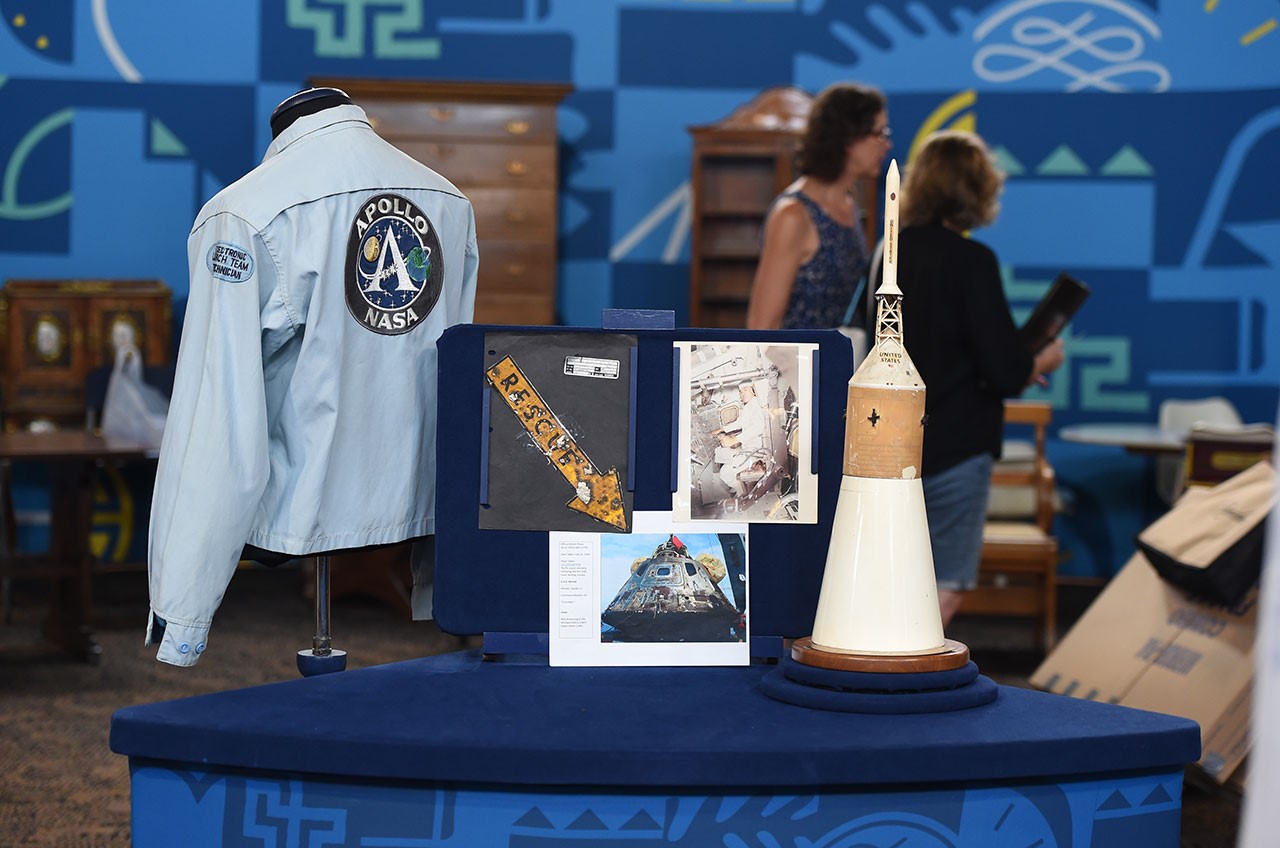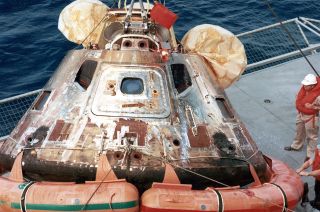Apollo 11 Spacecraft Tags Land on 'Antiques Roadshow' for Appraisal

Only a few days after the Smithsonian's announcement of a national tour for Columbia, the historic spacecraft that flew the first men to walk on the moon, two notable artifacts from the Apollo 11 command module have turned up at a different type of roadshow.
On the next new episode of "Antiques Roadshow," airing on PBS on Monday night (Feb. 27), an engineer who worked on Columbia before and after its 1969 journey to the moon shares his collection.
"When the spacecraft would come back to Downey [Calif.], we would strip them all down," explained the retired North American Aviation (now Boeing) engineer, whose name is not given on the television show. "And so this arrow... they were scraping all this stuff off and throwing it away in a big pile, so they just gave it to me." [NASA's Apollo 11 Mission in Pictures]
The gold-color arrow decal, which reads "RESCUE," had been affixed to Columbia's crew access hatch, pointing to the panel to gain entrance to the crew cabin. Normally, the astronauts would open the hatch from the inside, but in the case of a problem or emergency, the arrow would serve to direct rescuers to where the find the proper panel.
The arrow, almost 50 years later, still shows the wear and tear it received from Columbia's entry into the atmosphere as documented in photographs of the command module at the time of its splashdown in the Pacific Ocean.
The contractor was also given the main assembly parts tag removed from inside Columbia after the Apollo 11 mission. The tag identifies the spacecraft as a "Command Module," lists its part and serial numbers, and is embossed with two inspection marks.
"This label another guy gave to me because I was the final person to stamp it, saying 'Hey, we've got a good product," recounted the tag's owner. "This is the serial number, '107.' So we called it '107' and when it went to [Cape Canaveral], it became Apollo 11."
Get the Space.com Newsletter
Breaking space news, the latest updates on rocket launches, skywatching events and more!

Antiques Roadshow's appraiser, Matthew Quinn of Quinn's Auction Galleries in Virginia, was excited to see the Apollo artifacts.
"You realize that space nerds everywhere are going crazy right now?" said Quinn to the decals' owner while filming in Palm Springs, California.
Components of Columbia are rare in private hands. As the only part of the Apollo 11 spacecraft to return to Earth (the service module was jettisoned; the descent stage of Eagle, the lunar module, is still at Tranquility Base; and its ascent stage crashed back to the moon), the command module is considered a national treasure.
Small pieces of the thermal protection foil that covered the outside of the craft — saved as a memento by those who recovered and worked on the vehicle after splashdown — sell today for hundreds of dollars each, at minimum. Heat shield samples, removed as part of the post-flight testing and then embedded in acrylic for presentation by NASA to team members, have been auctioned for several thousand dollars each.
Perhaps the most significant artifact from Columbia sold to date, an exterior hand rail that was removed and released from federal property as a part of its post-flight testing, was sold for tens of thousands of dollars.
Quinn's appraisal of the arrow and parts tag is comparable with the hand rail. The two decals' estimated value though, adds to an even larger total based on two other mementos shown as part of the Roadshow segment — an "Electronic Launch Team Technician" jacket that originally sold for $40 and a vintage North American Aviation scale model of the Apollo spacecraft that the engineer had autographed by 15 astronauts, including Neil Armstrong and Buzz Aldrin.
Learning their value, the artifacts' owner said he intends to donate the decals to his niece, "so she'll be happy to hear that."
Antiques Roadshow has featured other space exploration artifacts over the course of its 39 years airing in the United Kingdom and the U.S. (the latter now in its 20th season). Recent appraisals have included the artwork for the Apollo 11 mission patch and the personal possessions of German rocket pioneer Wernher von Braun, as were brought to the Roadshow by officials at the U.S. Space & Rocket Center in Huntsville, Alabama.
The Apollo 11 command module is currently undergoing a conservation at the Smithsonian's National Air and Space Museum Steven F. Udvar-Hazy Center in northern Virginia. Columbia will depart on a two-year national tour later this year, visiting museums in Houston, Saint Louis, Pittsburgh and Seattle.
See more of the Apollo archive from the set of Antiques Roadshow at collectSPACE.
Follow collectSPACE.com on Facebook and on Twitter at @collectSPACE. Copyright 2017 collectSPACE.com. All rights reserved.
Join our Space Forums to keep talking space on the latest missions, night sky and more! And if you have a news tip, correction or comment, let us know at: community@space.com.

Robert Pearlman is a space historian, journalist and the founder and editor of collectSPACE.com, a daily news publication and community devoted to space history with a particular focus on how and where space exploration intersects with pop culture. Pearlman is also a contributing writer for Space.com and co-author of "Space Stations: The Art, Science, and Reality of Working in Space” published by Smithsonian Books in 2018.In 2009, he was inducted into the U.S. Space Camp Hall of Fame in Huntsville, Alabama. In 2021, he was honored by the American Astronautical Society with the Ordway Award for Sustained Excellence in Spaceflight History. In 2023, the National Space Club Florida Committee recognized Pearlman with the Kolcum News and Communications Award for excellence in telling the space story along the Space Coast and throughout the world.











